
|
|

August 20, 2010
Tucson, 2009 (Part I)
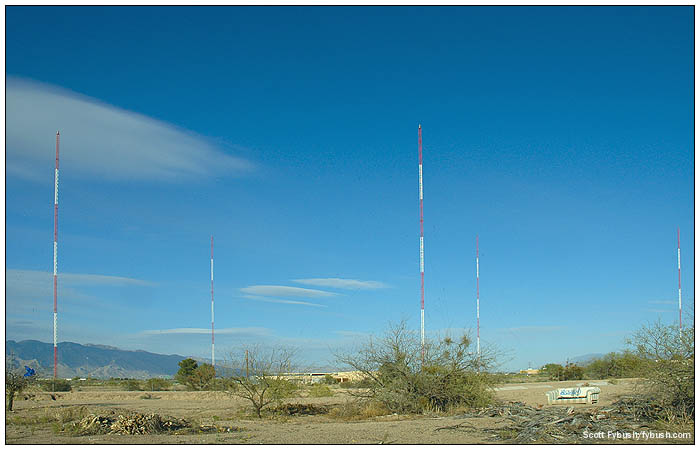
This week's installment marks two beginnings here at Site of the Week: it's the first of two installments of pictures from a brand new market to us - Tucson, Arizona - and it's the first in an ongoing series of Site of the Week installments showing off the images you'll see when you order Tower Site Calendar 2011, which is at the printer right now and will be shipping beginning right after Labor Day.
That picture at the top of the page is our May 2011 calendar picture - and while it might look like nothing more than five average guyed towers (and a graffiti-scarred dead sofa!) in the midst of some desert scrub, it means much more to anyone who's familiar with the history of top-40 radio.
Unlike so many other formats, the roots of top 40 were in smaller markets. Before there was a WABC or a KHJ or a WLS, there were incredibly influential, inventive stations such as KOWH in Omaha, KYNO in Fresno...and KTKT in Tucson.
At its beginning in 1949, KTKT was indistinguishable from the thousands of other little independent radio stations that sprung up after the war: 250 not-so-big watts on 1490, the fifth station in what had already been a pretty crowded little four-station market. (Tucson was a small town back then, with just 45,000 people in the metro area in 1950!)
But little KTKT grew - it moved down the dial to 990 and cranked up the power to 10,000 watts, at the expense of going daytime-only. And in May 1957, it gave a young DJ named Frank Kalil the go-ahead to change format, flipping from all-over-the-road to straight-ahead top-40.
For the next two decades, "Color Radio 99" would be one of the most influential top-40 stations in this part of the country - and long after the music stopped playing, the towers off West Grant Road were still standing, and still on the air with the KTKT calls, when we parked ourselves in a nearby motel one April evening in 2009. Today's KTKT is an ESPN Deportes outlet, and it's once again a fulltimer, operating with four of those five towers by day and a somewhat different four-tower array at night.
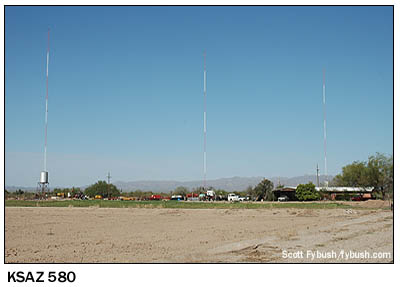
|
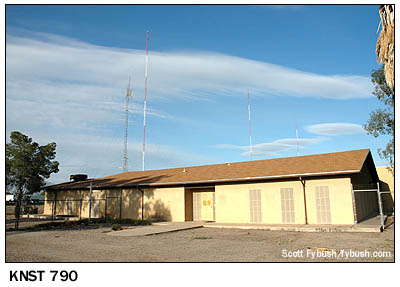 |
But while KTKT may be the best-known Tucson station outside Tucson, it's neither the only AM signal here (not by a long shot!) nor the first one we saw on our 2009 trip.
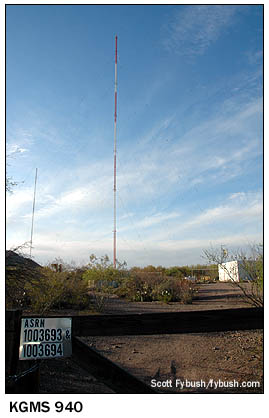
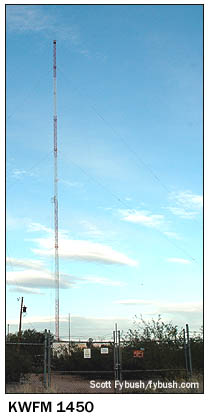 That honor went
to KSAZ, the station on 580 licensed to Marana, some 20 miles
north of Tucson on I-10 (which runs north-south here, even though
it's signed east-west). In our next installment, coming up in
two weeks, we'll explore more of the tangled history that led
Tucson's 580 signal to this out-of-the-way spot from its former
central location; for now, we'll note that 580 had an unbuilt
construction permit not long ago to move away from Tucson and
up toward Phoenix, 90 miles to the north.
That honor went
to KSAZ, the station on 580 licensed to Marana, some 20 miles
north of Tucson on I-10 (which runs north-south here, even though
it's signed east-west). In our next installment, coming up in
two weeks, we'll explore more of the tangled history that led
Tucson's 580 signal to this out-of-the-way spot from its former
central location; for now, we'll note that 580 had an unbuilt
construction permit not long ago to move away from Tucson and
up toward Phoenix, 90 miles to the north.
From our motel on West Grant, just across I-10 from downtown Tucson, it was a quick drive to several other AM sites on the west side of town.
On Silverbell Road, almost within spitting distance of the KTKT towers, we found the three towers of KNST (790), now Clear Channel's news-talker. That building at the base of the array is shuttered now and used only for the AM transmitter, but it was once a thriving studio facility for both the AM station (under its old calls, KCEE) and eventually a sister FM, KWFM (92.9).
(This is my cue to credit the source for much of this information: Barry Mishkind is not only the proprietor of the Broadcaster's Desktop Resource, a wonderful place for broadcast history and current information - he's also a longtime Tucsonan, veteran of many of these stations and maintainer of a very nice page of Tucson radio history at his site!)
The KNST calls that now live on 790 used to be on the next AM station to the south, at 940 on the dial. This two-tower array off Greasewood Road and San Juan Trail in southwest Tucson started out in the sixties as KHOS, an early country station; it later inherited the KCEE calls from 790 and eventually went religious under its current calls, KGMS.
There's one more AM station west of I-10: KXEW (1600) was the first Spanish-language station in town, drawing its callsign from Mexico City's biggest AM station. Its two-tower array lacks the punch of XEW's 250 kilowatts south of the border, but its central location just off I-10 on El Puente Lane still does a nice job of covering the city.
The KWFM calls that used to be on 92.9 are still in the Clear Channel family, but they're now on a small AM signal. KWFM (1450), with a lonely little tower off E. 28th Street in a run-down part of the city, now does automated oldies - but back in the day, this frequency was a much more important player in town: it was KOPO, part of the Gene Autry empire and a sister to Phoenix's famous KOOL. KOPO begat KOPO-TV (Channel 13), which eventually became today's KOLD, and the radio station used to be located behind the TV studios near downtown.
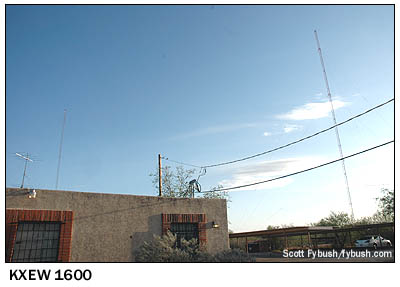
|
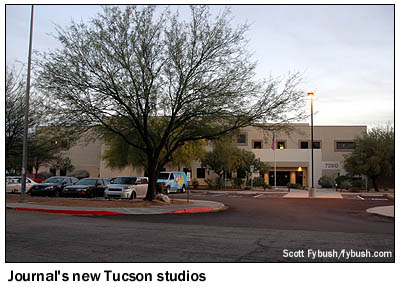
|
There's one more Tucson site on our agenda before the sun goes down this April evening: Journal Broadcast Group had recently consolidated its studios way out on the east side of town, and that building at 7280 Rosewood is our last stop as the sun begins to set. It's home to ABC affiliate KGUN (Channel 9) and three radio stations: sports KFFN (1490, the original KTKT frequency), KMXZ (94.9), KGMG (106.3) and KQTH (104.1).
We'll see some of their transmitter sites, a few more studios, and most of the rest of Tucson in our next installment on September 3 - but in the meantime, feed your thirst for more Tucson broadcast history not only at Barry's sites above, but at some nifty tribute sites for KTKT and KWFM, too. (And we'll have lots of Tucson IDs over at TopHour.com after Labor Day, too...)
 - Find out when the new Tower Site is posted,
and much more! Follow us on Twitter @NERadioWatch - and don't miss your chance to pre-order the
all-new Tower Site Calendar 2011 at the Fybush.com
store!
- Find out when the new Tower Site is posted,
and much more! Follow us on Twitter @NERadioWatch - and don't miss your chance to pre-order the
all-new Tower Site Calendar 2011 at the Fybush.com
store!- Previous Site of the Week: WWVA, Wheeling, WV
- In Two Weeks: Tucson, part II
- Site of the Week INDEX!
- How can you help support Site of the Week? Click here!
- Submit your suggestions for a future Site of the Week!

